Tall succulent plants add an impressive vertical dimension to gardens, landscapes, and indoor spaces. These plants provide amazing focus points because of their eye-catching foliage and exquisite architectural design.
Tall succulent plants, such as stately agaves and towering cacti, are low care and aesthetically pleasing plants that can grow in a variety of conditions.
Different Types of Tall Succulent Plants
Snake Plant

The scientific name for the Snake Plant is Sansevieria or Dracaena trifasciata. Because of its long, thin, strap-shaped leaves, it is sometimes called mother-in-law’s tongue.
If you don’t overwater it, this succulent, which thrives on neglect, is among the hardest to kill.
When growing under the right conditions, its variegated foliage can grow up to six feet tall, giving indoor spaces a stunning vertical aspect.
Because it can tolerate little light and little watering, this hardy plant is a favorite among novices and people with hectic schedules.
The Snake Plant infuses every space with resilience and flair thanks to its sleek, architectural design.
Mother of Millions

The Mother of Millions, or Kalanchoe delagoensis as it is officially named, is a special kind of succulent that helps other plants develop by producing a lot of plantlets along the edges of its leaves.
It can grow to remarkable heights of up to 7 feet with a spread of 3 feet in its natural habitat.
However, because of how quickly it reproduces, it is regarded as invasive in some areas.
A interesting addition to succulent collections for enthusiasts wishing to observe its unusual reproductive technique in action, this succulent’s prolific growth and ease of propagation offset its invasive tendencies.
Desert Rose
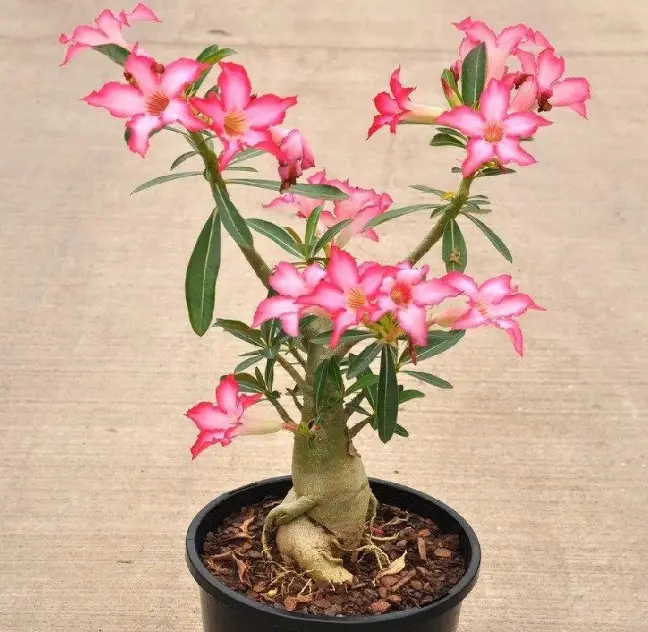
The scientific name for the desert rose is Adenium obesum, and it is a striking plant with pink to dark red blossoms that add to its height of about 4 feet.
Its delicate leaf and strong, spiky stem add to its attractiveness, making it a remarkable presence in any setting.
This adaptable plant can be cultivated indoors in pots, especially in colder climates where it flourishes as a hardy houseplant, or planted outside as a decorative focal point or bonsai specimen.
With its gorgeous blooms and versatile character, the Desert Rose infuses any setting with an air of exotic elegance.
Sticks on Fire
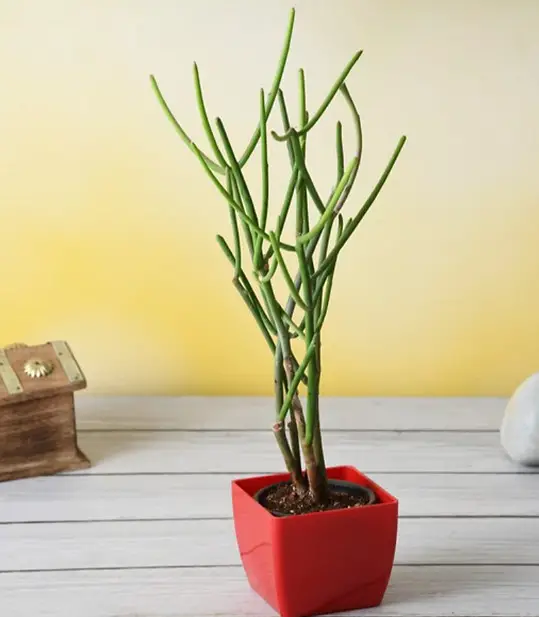
Sticks on Fire, or Euphorbia tirucalli as it is scientifically named, is known by the names “fire sticks” and “pencil trees” because of its thin, cylindrical branches that resemble burning red-gold sticks or pencils.
This hardy plant, which can grow up to 8 feet tall and resists pests and diseases, is a great fit for a variety of environments.
Its eye-catching look enhances borders, beds, coastal gardens, and even container gardens with a splash of color and texture.
Sticks on Fire is a distinctive and eye-catching addition to any indoor or outdoor area because to its low-maintenance requirements and distinctive appearance.
Jade Plant
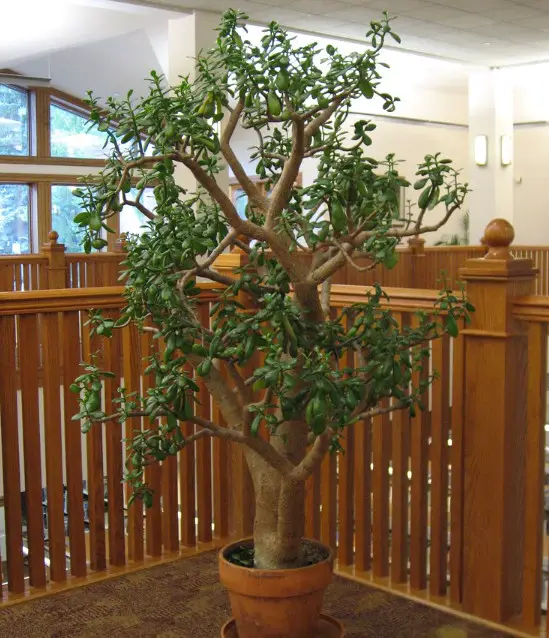
The low-maintenance succulent plant known as the jade plant, or scientifically named Crassula ovata, is prized for its symbolic meaning of good fortune and luck. When exposed to direct sunlight, the glossy green leaves of this plant becomes reddish in color.
Even while it grows slowly, it can eventually reach heights of 5 to 6 feet, which makes it a visually impressive addition to any outdoor or interior area.
The jade plant is not just a beautiful ornamental plant but also a treasured emblem of prosperity and well-being in many cultures due to its tenacity and symbolic meaning.
Foxtail Agave
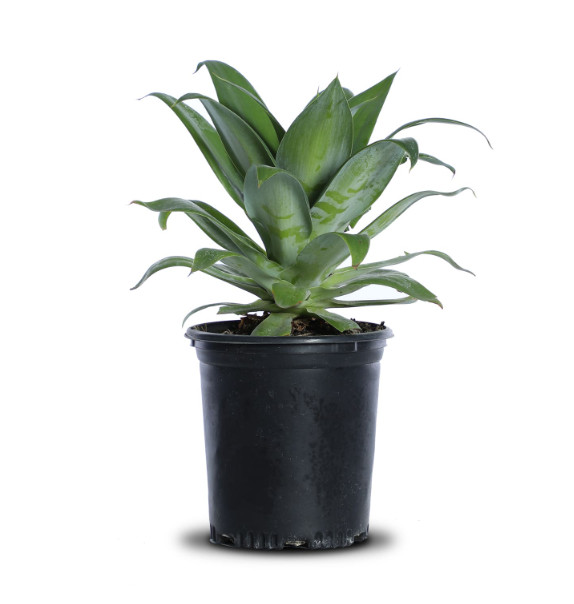
The scientific name for the Foxtail Agave is Agave attenuata, and it stands out in any landscape thanks to its eye-catching silvery-green leaves rosette.
It is a low-maintenance evergreen succulent perennial that does best in bright sunlight, though it can handle slight shade.
Its inflorescence, which may grow up to 10 feet tall, usually has curved stems with greenish-yellow petals that give it a striking appearance.
The Foxtail Agave is a popular choice for adding architectural interest and visual appeal to gardens, landscapes, and container arrangements because of its unusual form and tolerance to a variety of growth environments.
Aloe Vera

Scientifically named Aloe barbadensis miller, aloe vera is a multipurpose plant well-known for its therapeutic and beauty properties. It is a mainstay in skincare products and treatments for burns, wounds, and skin irritations because its fleshy leaves contain a gel that is high in nutrients and antioxidants.
Aloe vera is small in containers, but grown properly, it can grow to remarkable heights of about three feet. It needs six to eight hours of sunlight a day to flourish, and well-draining soil to avoid soggy roots.
Aloe vera is a useful and beautiful plant that looks great indoors or outdoors.
African Milk Tree
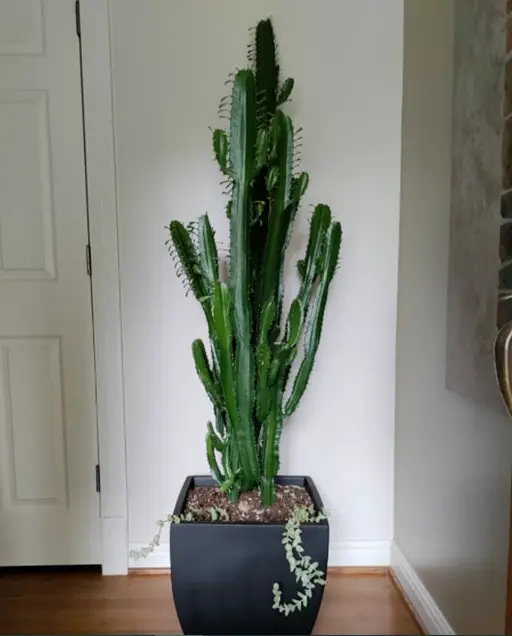
Scientifically called Euphorbia trigona, the African Milk Tree is endemic to central Africa and grows well there. When grown outside, it thrives and grows to be an amazing hedge that reaches up to nine feet in height.
It falls short of its potential indoors, though. Sometimes called the “Good luck cactus,” it has an amazing appearance due to its unique triangular stems with three ridged sides.
Due to its striking appearance and quick growth, this succulent is a popular choice for people looking to add something eye-catching to their indoor or outdoor area.
It is a beloved botanical specimen due to its hardiness and unique appearance.
Saguaro
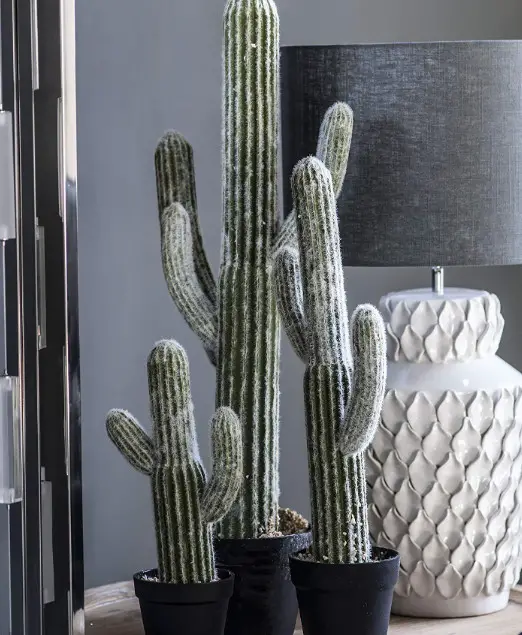
Known by its scientific name, Carnegiea gigantea, the saguaro is one of the tallest stem succulents in the United States.
With a remarkable lifespan spanning more than 150 years, it can reach heights of up to 40 feet.
Many Saguaros grow taller as they age because of the branches that keep growing vertically.
With their distinctive slow-growing growth and silhouette, these well-known cacti represent adaptability and perseverance in difficult desert environments and are long-lasting icons of the dry landscapes they live in.
Candelabra Spurge
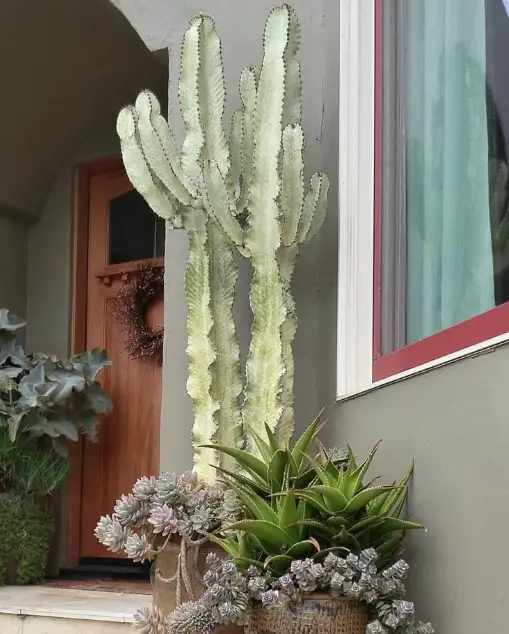
Scientifically called Euphorbia ammak ‘Variegata,’ Candelabra Spurge gets its name from the candelabra-like shape that its branches make.
It stands out against creamy-yellow and pale blue surfaces thanks to its strong, wavy ribs and four wings with dark brown spikes.
When it reaches maturity, it can spread out 6 to 8 feet and reach heights of 15 to 20 feet, giving it a dominant presence in any setting.
Candelabra Spurge lends a bit of architectural flair and texture to gardens and outdoor areas with its distinctive form and eye-catching features.
Century Plant

Agave americana, or the Century Plant as it is officially named, is a highly prized decorative agave that grows in many parts of the world. Any landscape is enhanced by the beautiful rosette of bluish-green leaves that are embellished with spiky edges.
The architectural elegance and hardiness of the Century Plant make it a standout choice for either a container garden or a focal point in a backyard garden.
Given its low maintenance requirements and striking foliage, it’s no surprise that gardeners and landscapers who want to lend a sophisticated touch to outdoor areas love this agave.
Madagascar Palm
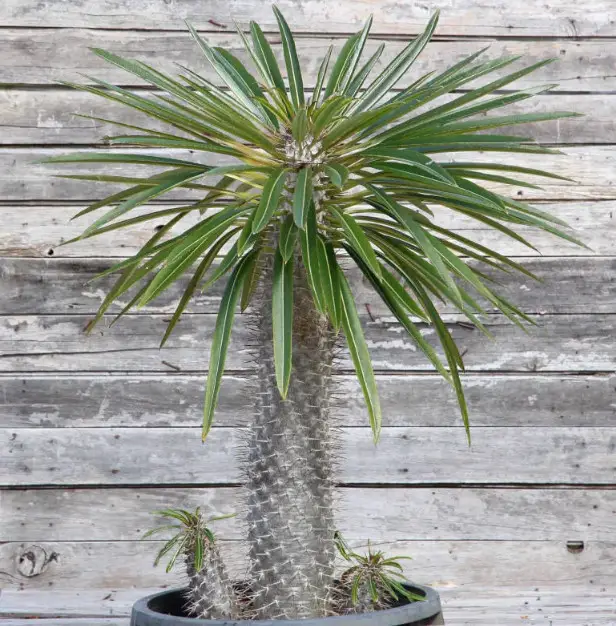
The Madagascar Palm, scientifically known as Pachypodium lamerei, has long, leathery green leaves that sit atop a thick succulent stem, giving it an air of exotic beauty.
It usually reaches a more manageable 5–6 feet indoors, but it can go as high as 20 feet outdoors.
This plant has sharp spines all throughout its stem, so handle it with caution.
The Madagascar Palm is a fascinating addition to any garden or indoor space, reminding us of the distinctive flora found in its original habitat and adding a touch of tropical elegance despite its spiky appearance.
Elephant’s Ear Kalanchoe

Known by its scientific name Kalanchoe beharensis, the Elephant’s Ear Kalanchoe is also known as the Felt bush.
Growing to a maximum height of 5 to 10 feet, its velvety texture and ruffled edges add to the olive-green foliage’s attractiveness.
It’s crucial to remember that this kalanchoe cannot withstand frost and needs protection from the cold in order to flourish.
Elephant’s Ear Kalanchoe is still a popular choice for gardeners and enthusiasts looking for a statement plant because of its eye-catching leaf and remarkable stature, even though it is sensitive to frost.
It gives both indoor and outdoor areas a hint of exotic appeal.
Eve’s Needle
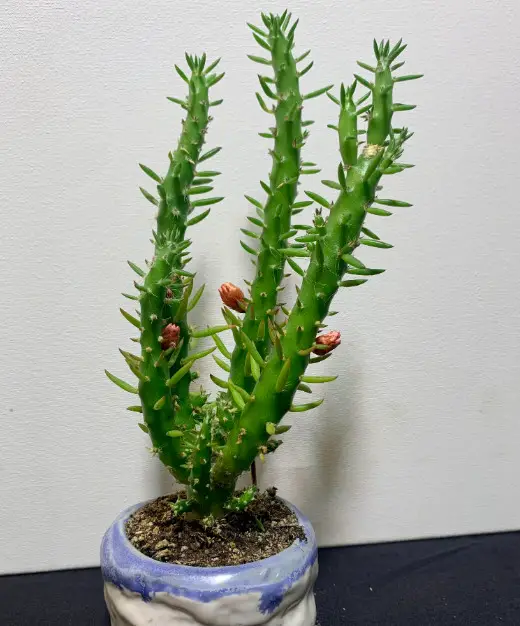
Austrocylindropuntia subulata, the scientific name for Eve’s Needle, is a plant with cylindrical stems that are covered in long spines that resemble classic cacti.
When fully grown, it can reach as much as 4 feet in height, and the terminals of its stalks are covered in blossoms.
Several other names for this succulent exist, such as Chumbera Fina, Long Spine Cactus, and Eve’s Pin Cactus.
Eve’s Needle is a popular option among lovers of arid plants and cacti because of its remarkable silhouette and hardy character, which lends a hint of desert appeal to gardens and landscapes.
Jumping Cholla

Cylindropuntia fulgida, the scientific name for the Jumping Cholla, is a unique tree-like cactus that may grow up to a height of 13 to 15 feet.
Its strong stem holds branches that extend outward from its center, forming a remarkable outline.
The plant’s unusual appearance is further enhanced by the nearly complete obscurity of its nearly spine-covered stems.
Limit watering to avoid overhydration, make sure there is bright light, and make sure there is enough sunlight for optimal growth.
The Jumping Cholla is a striking focal point that highlights the beauty and tenacity of desert flora in dry settings and desert gardens thanks to its imposing stature and distinctive features.
Queen of the Night
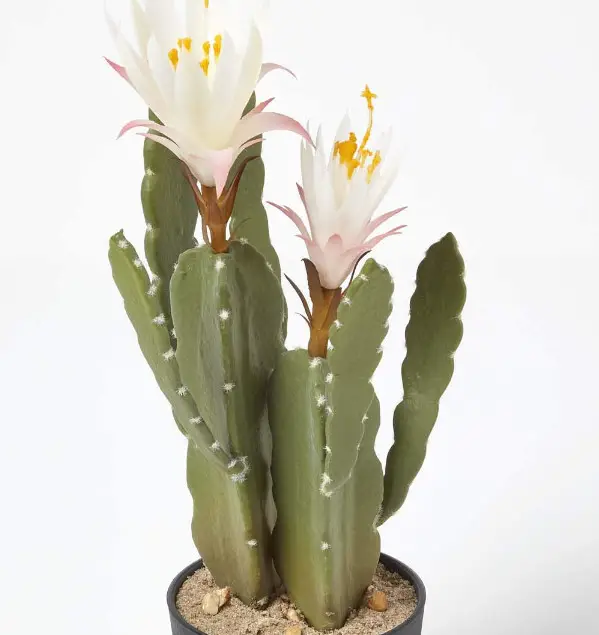
The Queen of the Night, or Epiphyllum oxypetalum as it is officially titled in science, is a fascinating plant that only blooms once a year and is also known as the Orchid Cactus.
Growing on trees and other surfaces in its native tropical habitat, it is a successful epiphyte.
Its extraordinary propagation capacity through leaf cuttings allows enthusiasts to cultivate their own Queen of the Night plants.
This extraordinary cactus brings a sense of mystery and beauty to any collection of tropical or exotic plants with its captivating blossoms and unusual growth pattern.
Ocotillo
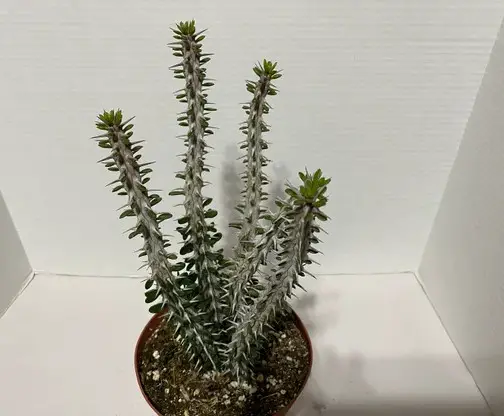
With its characteristic long cylindrical stems, the Ocotillo, technically known as Fouquieria splendens, draws attention in the Sonoran and Colorado deserts.
This desert plant reaches up to 33 feet in height, branching out at the base, but as it gets higher it becomes more likely to have solitary stems.
The Ocotillo is a distinctive feature of arid landscapes because to its unique growth pattern and dramatic form. It serves as a functional and aesthetic aspect, giving wildlife habitat and bringing visual interest to desert ecosystems.
Prickly Pear Cactus

Opuntia, the scientific name for the prickly pears cactus, is well known for its hardiness; it can survive in cold climates with USDA zones as low as four. Its leaves are made up of oval-shaped, spine-adorned pads that give it a unique look.
This cactus’s height ranges from a few inches to over fifteen feet, demonstrating its adaptability and plasticity.
Notwithstanding its reputation for being prickly, the Prickly Pear Cactus is a beloved cactus that is valued for its hardiness, distinctive beauty, and capacity to flourish in a variety of climates, making it an invaluable addition to gardens and landscapes all around the world.
Burbank’s Spineless Cactus
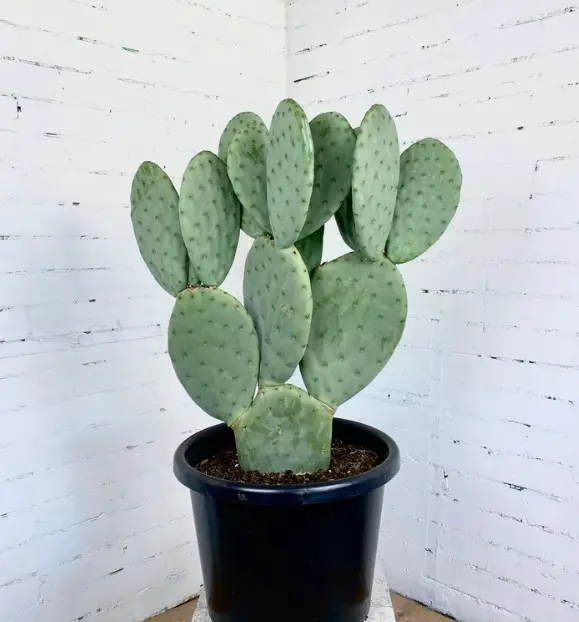
For those looking for a cactus without sharp thorns, Burbank’s Spineless Cactus, also known by its scientific name Opuntia ficus-indica, is a great option. It resembles a prickly pear but doesn’t have any spines.
It makes a visually pleasing addition to gardens and landscapes with its broad, flat branching pads that resemble those of its spiny relatives.
Burbank’s Spineless Cactus is a desirable substitute for those who would rather not have to worry about prickling cacti.
It continues to be a well-liked option for succulent aficionados and gardeners who want to choose plants that are safe and beautiful at the same time because of its distinctive qualities and low maintenance requirements.
Fishhook Barrel Cactus
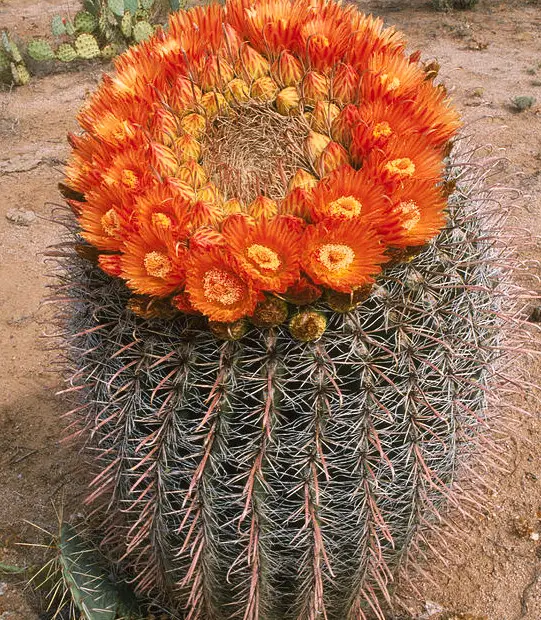
The Fishhook Barrel Cactus, scientifically known as Ferocactus wislizeni, gets its name from its barrel-like form that it takes on when it grows to a height of three to six feet.
This hardy cactus adds a pop of color to its dry desert surroundings with its vivid blooms, which range in hue from bright orange to yellow.
The Fishhook Barrel Cactus flourishes in spite of its tough surroundings, demonstrating its flexibility and beauty even under the most trying circumstances.
It is a compelling feature in desert landscapes and a representation of resiliency in hostile circumstances because of its unusual look and eye-catching blossoms.
Organ Pipe Cactus
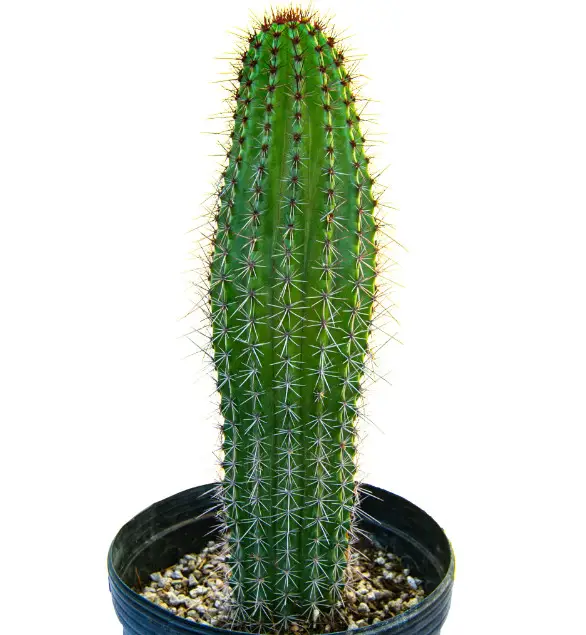
The 26-foot-tall Organ Pipe Cactus is a tall plant that is native to South Arizona and Mexico. Growing to thrive in USDA Hardiness Zones 9 through 11, it adds a grand presence to barren desert environments.
It looks great in rock gardens and is ideal for rocky places. The Organ Pipe Cactus gets its name from growing vertical evergreen tubes that resemble church organ pipes, in contrast to conventional succulents that have leaves.
Delightful white blooms bloom at the top of each branch throughout blooming season, lending a touch of refinement to its already striking stature.
Senita Cactus

The Senita Cactus, native to Mexico and Arizona, is a towering plant that can grow up to 15 feet tall. Growing well in USDA Hardiness Zones 8b through 11b, it demonstrates adaptability and resiliency.
The Senita Cactus has a distinctive and remarkable appearance, with a robust base giving way to vertical stems that are topped with hairy beards and decorated with up to 15 ribs apiece.
Its pale pink blooms that open only at night make it noteworthy for its nocturnal flowering habit and add to its attractiveness.
This drought-resistant succulent, which thrives in well-draining soil and is protected from intense cold, is a valued addition to desert landscapes.
Crown of Thorns
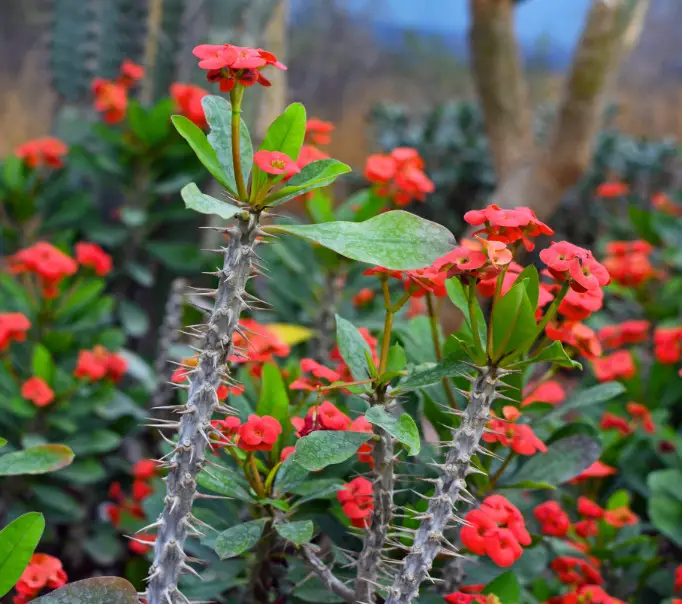
The Christ plant, or Crown of Thorns, is a tall succulent that may grow up to six feet tall and is native to Madagascar. It has vivid flowers and green foliage that require little care. It’s important to remember that although being ideal for indoor growing, it is extremely hazardous to people and pets.
While propagation from seeds is feasible, cuttings allow for faster growth. In soil that drains properly, new succulents can sprout with ease. Handling it should be done carefully because the sap might irritate the skin and eyes. Wearing gloves is always a good idea when performing maintenance on the Crown of Thorns.
Yucca
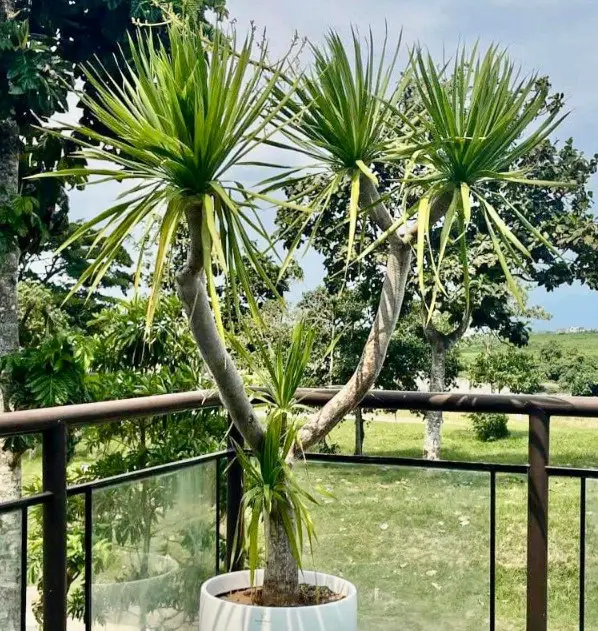
Native to North America, the Yucca is a visually arresting succulent that dangles sword-like leaves that add interest to any arrangement.
It can grow in both indoor and outdoor settings, requires little care, and can withstand drought.
It can grow as high as thirty feet with the correct lighting, watering, and fertilizing conditions; however, outdoor growth is more likely to achieve this.
Watering infrequently and letting the soil dry out in between is advised for best growth.
The Yucca brings a hint of desert elegance to any interior design or landscape, whether it is grown as a magnificent outdoor specimen or as a houseplant.






